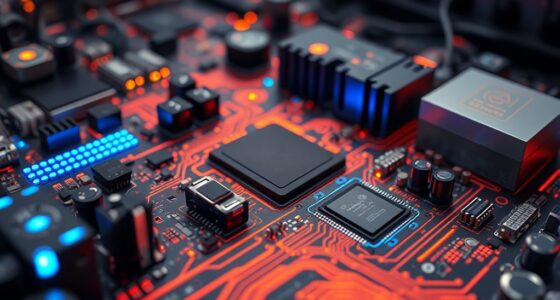By 2025, you’ll see AI workloads shift from model development to deployment and real-time inference. Focus moves toward optimizing models with pruning, quantization, and specialized hardware like GPUs and TPUs, enabling faster responses and efficiency. Hardware accelerators make deployment across devices more practical, supporting edge and cloud applications. As this trend advances, understanding these changes will help you better leverage AI’s full potential—keep exploring to discover how to stay ahead in this evolving landscape.
Key Takeaways
- Inference now drives AI deployment, prioritizing real-time, efficient model responses over initial training processes.
- Model optimization techniques like pruning and quantization enable faster, smaller models suitable for diverse hardware environments.
- Specialized hardware such as GPUs, TPUs, and custom accelerators significantly enhance inference speed and energy efficiency.
- Cloud and edge deployment strategies facilitate rapid, scalable AI inference closer to users, reducing latency.
- Advances in hardware and optimization are shifting AI workflows to focus predominantly on inference beyond 2025.

As artificial intelligence advances, inference—applying trained models to real-world data—has begun to surpass the importance of the initial training process. This shift reflects a broader shift in AI workflows, where the focus now centers on deploying models efficiently and effectively rather than solely on their creation. Inference is where AI delivers tangible value, whether powering voice assistants, real-time translation, or autonomous systems. To meet these demands, you need to optimize models for faster, more efficient inference, which has become a critical area of development. Model optimization techniques, such as pruning, quantization, and knowledge distillation, reduce model size and complexity without sacrificing accuracy. These methods enable models to run more quickly on available hardware, making real-time responses feasible even in resource-constrained environments.
Hardware acceleration plays a pivotal role in this transformation. You’re likely leveraging specialized hardware like GPUs, TPUs, or custom accelerators designed specifically to speed up inference tasks. These hardware options significantly outperform traditional CPUs in handling the parallel processing required for complex models. The integration of hardware acceleration isn’t just about raw speed; it’s about making inference more energy-efficient and scalable. When models are optimized for specific hardware, you can deploy AI solutions across a wider range of devices, from cloud servers to edge devices, without compromising performance. This trend is especially important as AI applications become more embedded in daily life, demanding rapid responses with minimal latency.
The importance of inference over training also influences infrastructure choices. You’re moving toward architectures that support rapid model deployment and updating, such as cloud-based inference services or edge computing solutions. These setups allow you to run models closer to the end-user, reducing data transfer times and improving user experience. As models become more refined and efficient, your focus shifts from developing new architectures to deploying and maintaining existing ones at scale. This means investing in hardware that accelerates inference and adopting model optimization strategies to ensure your AI solutions are both fast and cost-effective.
In essence, the technological advancements in model optimization and hardware acceleration are transforming AI workflows. You’re now prioritizing the deployment phase—turning trained models into practical tools that deliver real-time results—over the initial training process. This evolution promises more responsive, scalable, and accessible AI applications, shaping the future landscape of artificial intelligence in 2025 and beyond. Additionally, dedicated hardware designed specifically for inference tasks accelerates this transition by providing tailored performance improvements.
Frequently Asked Questions
How Will Hardware Needs Evolve With Inference Dominance?
As inference dominates, you’ll see hardware needs evolve towards greater scalability and energy efficiency. You’ll need more adaptable hardware that can handle increasing workloads without sacrificing speed or increasing energy consumption. Focus on scalable architectures and energy-efficient chips to optimize performance. This shift means investing in hardware that supports rapid inference, reduces power use, and can easily grow with AI demands, ensuring your systems stay competitive and sustainable.
What Industries Benefit Most From Inference-Focused AI Workloads?
Think of industries like healthcare, retail, and finance as sleek ships steering the vast ocean of AI. They benefit most from inference-focused workloads, using real-time data to steer decisions swiftly. Your industry adapts quickly, harnessing this AI shift to accelerate innovation and stay ahead of competitors. As inference becomes dominant, your sector gains sharper insights, streamlined operations, and a turbocharged edge in transforming customer experiences and operational efficiency.
How Will This Shift Impact AI Research and Development Timelines?
You’ll find that the shift towards inference-focused workloads speeds up AI R&D timelines because improved model efficiency means less computational power needed, and higher dataset quality guarantees more accurate results. As a result, you can iterate faster, refine models more effectively, and deploy solutions quicker. This shift reduces delays and enhances innovation, allowing you to stay ahead in competitive markets while making the most of your data and computational resources.
What Are the Environmental Implications of Increased Inference Workloads?
Imagine you’re running a large AI-powered data center, and increased inference workloads cause energy consumption to rise sharply. This drives up the carbon footprint, worsening environmental impact. As inference tasks dominate, you’ll need to contemplate more sustainable energy sources and optimize models for efficiency. Otherwise, the environmental implications—higher emissions and resource depletion—could outweigh AI’s benefits, challenging your commitment to eco-friendly innovation.
How Will This Trend Influence AI Talent and Skill Requirements?
You’ll find that as inference workloads grow, AI talent needs to focus more on optimizing models and deploying solutions. You should prioritize AI education that emphasizes inference techniques, real-time processing, and energy efficiency. Talent retraining becomes essential, so you can adapt to changing demands and stay competitive. Developing skills in lightweight models and efficient algorithms will help you meet industry needs and drive innovation in this evolving landscape.
Conclusion
As 2025 unfolds, inference takes center stage like a rising star, illuminating the path forward in AI. You’ll find yourself riding the wave of this seismic shift, where workloads flow like a mighty river, reshaping the landscape. Embrace this new dawn, for it’s not just a change—it’s a revolution that transforms your journey, turning complex mountains of data into a smooth, flowing stream of insight, guiding you confidently into the future.










